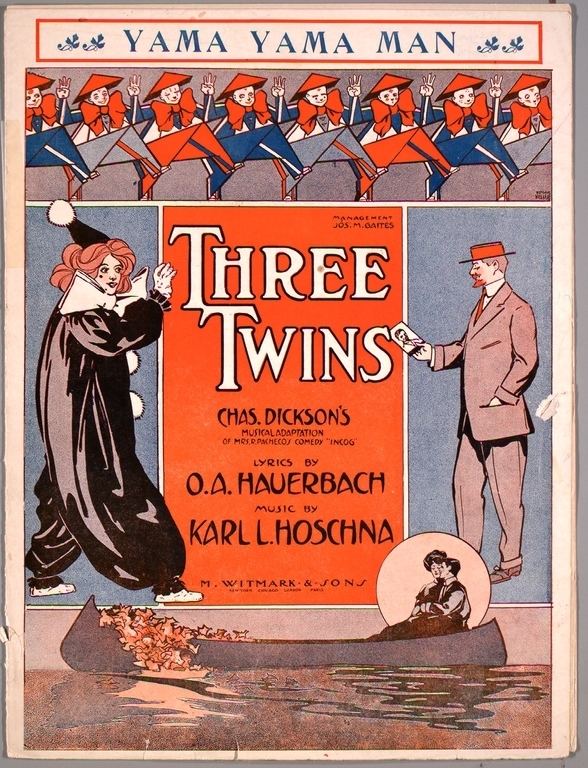Published M. Witmark & Sons Lyricist(s) Collin Davis | ||
 | ||
"The Yama Yama Man" was a comical song for the Broadway show The Three Twins, published in 1908 by M. Witmark & Sons with music by Karl Hoschna and lyrics by Collin Davis. It became popular after Bessie McCoy's animated performance in a satin Pierrot clown costume with floppy gloves and a cone hat. At age 20, she became an overnight sensation on Broadway and was known thereafter as the "Yama Yama Girl"; it became her lifelong theme song, the show ran for 288 performances. The lyrics contain topical references of the era such as street cars and ladies' fashion while the refrain is about a comical bogeyman—the Yama Yama Man—who is "ready to spring out at you unaware". Bessie McCoy's song and dance routine was a standard into the 1930s with a prestigious lineage of imitators including Ada Jones, Marilyn Miller, Irene Castle and Ginger Rogers.
Contents
History
Bessie McCoy's signature performance was key in establishing the song's popularity. According to Marjorie Farnsworth, "thousands came to see Bessie sing and dance as the Yama Yama Girl and then came to see her again.... her knack of dancing the songs became so effective that she often did them in pantomime with the audience filling in the words." According to Joe Laurie Jr she was one of the most imitated routines in Vaudeville. Nell Brinkley, who saw McCoy perform, described her thus:
she swings on her heel and leaps away into a wild fantastic headlong dance—the dance of a crazy king's clown, half girl, half wild boy, heady with the wine of the Spring air at twilight … The black satin of her bloomers fills like sails, and they ripple and flatten against her body. Her hair flies in loose flax around her face, and her face is a vivid white candle flame in the yellow aureole of her hair … Her feet might be bounding white balls carrying her body with them in their tireless, leaping flight. She circles madly around the boards, touching lightly and rebounding from the jutting points of the painted mock scenery, like an imprisoned moth, or an elf hunting for some lost thing and fearful of being caught. She is wonderful.
The July 25, 1908, edition of Billboard magazine reported the following story how the Yama song originated. When The Three Twins was rehearsing in Chicago, prior to first opening, Karl Hoschna, the composer, was asked to furnish a "pajama man song". He wrote one called The Pajama Man only to learn that it could not be used owing to another pajama number booked at the Whitney Opera House the next day. Gus Sohlke, the stage director, happened to pass a toy store and saw in the window a doll built out of triangles. Realizing that this had never been used in stage work he decided to have a triangular man chorus in place of The Pajama Man. That afternoon as he, Collin Davis and Hoschna sat together wondering what they would call the song, Sohlke kept repeating Pajama jama yama yama. Suddenly he brightened up and cried "Did either of you fellows ever hear of a Yama Yama Man?" Of course neither one had and Sohlke confirmed "Neither have I! Lets call the new song Yama Yama Man". Quickly Davis set to work to write a lyric around the title and that night Sohlke and Hoschna locked themselves in a room with Bessie McCoy and rehearsed the Yama song and dance for five hours.
Influences
Ada Jones recorded "Yama Yama Man" in 1909 for Victor Light Opera Company. The lyrics for verse two and three were changed, verse two being more bawdy. It spent five weeks at #1 in 1909 and was the most popular song of her career. Stanley Kirkby recorded a version around 1912 accompanied by banjo.
In 1909, the young dancer Irene Foote began imitating Bessie McCoy's "Yama Yama Man" in amateur theatricals. Irene's mother would take her around to Broadway producers auditioning her talent using the Yama routine, but with little success. Irene later had a successful career in modern dance with her husband Vernon Castle and in 1939 Ginger Rogers played Irene in the biographical film The Story of Vernon and Irene Castle, in which Rogers re-enacts Irene imitating Bessie McCoy's "Yama Yama Man" routine during an audition (see film clip).
In Warner's Look For The Silver Lining (1949), June Haver plays Marilyn Miller imitating Ginger Rogers imitating Irene Foote imitating Bessie McCoy's performance.
The song led to a spin-off children's novel Yama Yama Land (1909) by Grace Duffie Boylan. Francis Scott Fitzgerald briefly mentioned it in The Beautiful and Damned (1922).
In 1967, actor George Segal released an LP titled "The Yama Yama Man", the title track is a ragtime version with horns and banjos. Segal apparently released the album due to his popularity doing same on The Tonight Show Starring Johnny Carson". In 1989, the Madison, Wisconsin punk band Tar Babies released a song "Yama Yama Man" on their album Honey Bubble but it has no connection musically or lyrically with the original, in name only.
The song continued to find an audience into the 21st century with a jazzy cover by Californian group The High Sierra Jazz Band that includes animated singing that is mostly faithful to the original lyrics and spirit of the song. The song was released on their album "We Got'Em".
In 1918, the cartoonist Max Fleischer created Koko the Clown, who appears to owe much to the Yama Yama Girl costume. Both Koko and Bessie McCoy wore clothing of loose black material, with three large white pom-poms in front and a white-trimmed neck frill. Both wore white foot coverings, white gloves with long fingers, and a hat with the same white pom-pom as in front. A 1922 sheet music drawing makes the connection explicit, saying "Out of the Inkwell, the New Yama Yama Clown", showing a picture of Koko.
